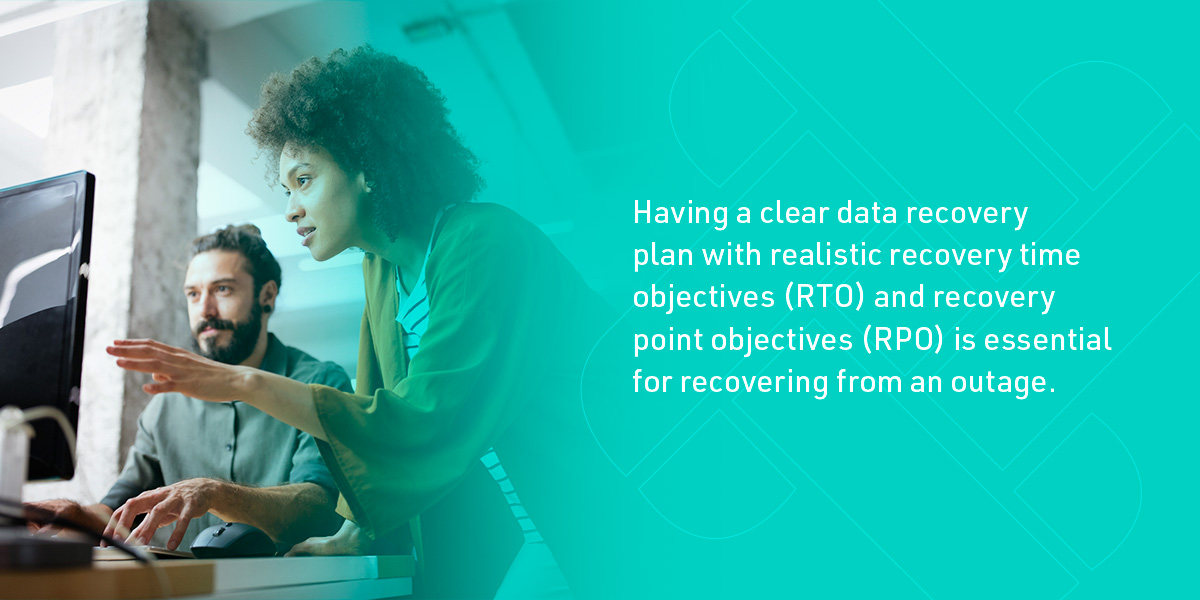The potential for digital data systems interruptions is a major threat that businesses must contend with. Finding fast, reliable and safe solutions to maintaining high availability during disaster or failure situations is critical to protecting data and maintaining business continuity.
One important solution businesses can adopt to keep their data systems running smoothly during failures and outages is implementing geo-redundancy in data centers and cloud computing services. With numerous data centers located around the world, it's becoming easier, more cost-effective and more accessible for organizations to adopt this mission-critical practice.
Follow our guide to geo-redundancy in cloud computing to learn more about how geo-redundancy works and the crucial benefits it provides to businesses with robust data protection needs.
In This Article
- What Is Geo-Redundancy?
- How Does Geo-Redundancy Work?
- What Is Geo-Redundancy in Cloud Computing?
- The 4 Levels of Data Redundancy
- Why Is Data Center Redundancy Essential for Businesses?
- The Benefits of Geo-Redundancy
- How to Protect Your Data With Geo-Redundant Solutions
- Secure Your Data With Bravura Safe and Privilege
- Choose Bravura Security for Geo-Redundant Data Protection
What Is Geo-Redundancy?
Geo-redundancy is a security and safety protocol that physically separates servers into multiple locations. Dividing up servers into different data centers provides a safeguard called geographical redundancy. It's a best practice to help organizations remain operational should one region be affected by natural disasters or catastrophic events. This approach is one tactic involved in a company's overall protection strategy known as a business continuity and disaster recovery (BCDR) plan.
Geo-redundancy differs from traditional server backups because it considers the physical nature of the server or hardware itself and its potential to be destroyed due to various causes. Geo-redundancy allows physically destroyed or compromised servers in one location to failover to other servers in other locations to continue operations seamlessly.
How Does Geo-Redundancy Work?
For geo-redundancy to work, physically separated servers must belong to the same network and have duplicated IT infrastructure. Complete backups and duplicates of one server need to be made on at least one other server located in a different data center in a different region. This duplication makes all server components available simultaneously so that if one is affected, the other remains functional and useable. When the primary server is down, it initiates a fast failover protocol to the secondary server, limiting the impact on operations.
Geo-redundancy is a critical strategy in helping to ensure better recovery point objective (RPO) and recovery time objective (RTO) metrics. With server duplication and redundancy, your organization will likely have a narrower RPO window in a shorter, faster RTO timeframe.
What Is Geo-Redundancy in Cloud Computing?
Geo-redundancy in cloud computing ensures cloud-stored data is stored on multiple cloud servers or hosted by multiple cloud storage service providers. Just as geo-redundancy with servers protects businesses against the loss of critical data when a primary server fails, redundancy in cloud computing defends against the risk of a cloud service becoming compromised.
Cloud services can become corrupted due to cyberattacks or other critical threats, or they can become temporarily unavailable. If this happens, you need to know your data has been backed up onto another cloud server or with another cloud storage service provider. Reputable cloud storage providers make sure their customers' data is stored across multiple machines and that the data is always accessible at any time, regardless of interruptions. Having constant availability to cloud storage is imperative to business operations, ensuring you can still access your information because it is stored in multiple locations.
The 4 Levels of Data Redundancy
Data, server and cloud computing redundancy are critical to all organizations. However, it's just as important to have a well-rounded and versatile redundancy strategy that covers multiple levels of data storage and computing.
Here are the four main levels of data redundancy that every business should cover in its BCDR plan.
1. Hardware Level

Despite the pervasive reliance on cloud computing for data storage and processing, hardware is still involved at some level. Wherever critical operations involve hardware, you should deploy a hardware-level redundancy plan.
You can take different hardware-level redundancy approaches, but outsourcing to a cloud-based infrastructure provider, like Amazon Web Services (AWS) or Azure, is the easiest. These platforms manage hardware-level redundancy for their users, so companies can benefit from the range of cloud services they provide without having to maintain physical data centers.
2. Process Level
Process-level redundancy refers to the ongoing availability of all business processes that make up the organization's digital architecture. Your organization can take an absolute approach and ensure redundancy of all processes or choose which mission-critical processes you need to safeguard through redundancy. Since some processes are more vital than others to business operations, selecting only some processes may be more practical and cost-effective.
Identify, list and rank order your processes in terms of necessary availability. Those with the highest availability requirements should have a thorough redundancy plan, while those with lower availability requirements may not need redundancy. Make this decision based on your internal systems, budget and needs.
3. Network Level
Network-level redundancy is the practice of having multiple ways to access digital assets through the internet and cloud services. Using AWS or Azure is the simplest way to ensure your network stays online and maintains security. AWS enables users to generate isolated networks through the virtual private cloud (VPC), while Azure uses a virtual private network (VPN).
Ensure you fully understand your service agreement with your network provider to determine whether redundancy is included and how it works. Since many network providers use the same infrastructure, having a secondary carrier may not provide the full-scale network-level redundancy you need.
4. Geographic Level
As previously described, geographic-level redundancy physically separates your servers or cloud storage devices into two or more different locations. The two server locations contain redundant data so the exact assets are always available in both primary and secondary locations. If the primary location fails, the secondary location remains available and operational with the same data from the primary source.
Managing geographic-level redundancy with your own data centers is a significant task and may bring high costs. Instead, plan out the geographic-level redundancy you need for your operations and research the legal and regulatory requirements that apply to where you can store data. Then configure geographic-level redundancy in AWS or Azure. Going through these platforms reduces your company's responsibility and is far more affordable than building your own data centers.
Why Is Data Center Redundancy Essential for Businesses?

While cloud services like AWS and Azure are the best options for data redundancy, even they are not perfect. Data servers might fail unexpectedly across an entire region, causing significant disruptions, including potential data loss. The ripple effects felt from a server failure affect an organization's productivity, connectivity and bottom line.
Having a clear data recovery plan with realistic recovery time objectives (RTO) and recovery point objectives (RPO) is essential for recovering from an outage. Understand your cloud service provider's service-level agreement to understand better what level of data recovery you can expect from the cloud provider.
Here are some top reasons why data center redundancy is essential for businesses.
Provides Data Protection
Businesses invest in cloud service providers that offer data recovery to guarantee their data remains protected no matter what. This protection is particularly vital when natural disasters strike. Hurricanes, tornadoes, blizzards, earthquakes and more can knock out power sources or even destroy data center buildings entirely.
Additionally, you'll want to consider the increasing frequency of disruptive power outages that impact business operations. A 2020 report found that utility users in the U.S. experienced a 73% increase in outage hours compared to 2019. The sharp rise in power outages is due to a surge in extreme weather events that year.
Both AWS and Azure provide recovery architecture to protect workloads for their users. For example, AWS replicates data using a data protection engine, while Azure continuously replicates data using asynchronous replication. Both cloud service providers enable organizations to test their data recovery processes without damaging the data.
Many organizations primarily run workloads on one cloud service provider and use another to provide enhanced data protection. By having multiple cloud service providers replicate your company's data, you can seamlessly protect your critical data and processes despite any sudden or ongoing circumstances in the affected region.
Minimizes Network Connectivity Issues
A secure network that performs efficiently is vital for cloud service platform users. You don't want to be caught in a scenario where you can't access your data or connect with vital partners and stakeholders. You definitely don't want interruptions to the services your customers depend on.
With AWS and Azure, businesses can minimize the degree of connectivity interruptions they may otherwise experience. Both cloud solutions maintain network connectivity, Azure through its VPN and AWS through elastic load balancing enabled by its VPC.
Sustains Productivity
Interrupted business processes in network and cloud computing can cost you significantly, leading to losses in productivity and other opportunities. By building data center redundancy into your business operations, you can maximize productivity during failovers and interruptions, reducing non-productive time.
Shortens Downtime
Data center redundancy offers rapid data recovery for your organization. Having multiple data centers to fall back on shortens the downtime between a primary server failing and a secondary server kicking in.
Rapid data recovery is vital to reducing losses in productivity and minimizing disruptive downtime that can cause chaos, missed opportunities or other costly implications, such as lost web traffic and interrupted communications with customers and stakeholders.
The Benefits of Geo-Redundancy

Geo-redundancy in the cloud provides priceless peace of mind that your business can continue running in unexpected or emergency outages. With geo-redundancy, data gets automatically restored to the most recent known state, allowing for unaffected business continuity. Businesses that establish geo-redundancy as part of their BCDR plans know having high availability means the difference between success and failure.
Here are the top benefits of implementing a geo-redundancy strategy for businesses:
- Optimizes data security by maintaining data availability: Geo-redundancy is essential for protecting your mission-critical data against a cybersecurity attack. When your IT staff isolates and resolves security issues, the downtime could leave your data vulnerable if it is only stored on one cloud server. Utilizing geo-redundancy in cloud computing ensures that your data is protected with your cybersecurity solutions at all times.
- Allows operations to continue during disaster recovery: When disaster strikes, you need a reliable solution to continue operations despite failures at one localized point. Geo-redundancy provides business continuity so systems can quickly recover when disasters occur and critical data, applications and processes remain available. To mitigate disruptions to operations, implement continuity plans, strategies and protocols that initiate automatically when one data center faces a disaster.
- Supports rapid recovery for minimal disruptions: It's crucial to business success to narrow the time between failover to full availability. Having rapid recovery times minimizes disruptions and protects precious business resources. With geo-redundancy, you can improve data center response times, limiting the effect on users. Geo-redundancy solutions do this by allowing more requests to happen concurrently and decreasing the number of round trips traffic takes from server to user.
How to Protect Your Data With Geo-Redundant Solutions
Geo-redundancy provides valuable data protection during key scenarios that can otherwise compromise business continuity and disaster recovery. With geo-redundancy, disasters have minimal impact on business operations because the distributed infrastructure incorporates a redundant server and frequent backups that provide an exact duplicate of the primary server.
Geo-redundancy is important because it protects your data from:
- Hardware failures: Protect your data from hardware failure with failover procedures. Failovers refer to the process of a system automatically switching its connection to a redundant or backup server after a primary server goes offline. When hardware fails, geo-redundancy allows processes to failover to a secondary data server replicating the primary server in a different region. Geo-redundancy is a superior solution to on-site backups or on-site redundant servers, which can be affected by the same issue as the primary server.
- Network outages: Network outages occur when service is interrupted for 60 seconds or more. With geo-redundancy, a primary network device and linked system will automatically switch to a secondary, redundant network device located in a separate and unaffected region. Having geo-redundant network infrastructure allows network and communication lines to remain functional despite the outage.
- Natural disasters: Geo-redundancy is a critical element of your disaster preparedness plan. Since natural disasters are unpredictable, your business must have a plan to account for various potential interruptions from natural disasters. By having geo-redundant servers and networks, you can continue operating even if the primary service suffers an outage or complete destruction.
Secure Your Data With Bravura Safe and Privilege
When disruptions occur due to hardware failovers, network outages or even natural disasters, your business needs a guaranteed continuity solution to keep data safe, protected and available during any interruption. Bravura Security products can be key elements of this strategy on two primary fronts.
- Ensuring you always have the hardware, network, operating system, and software credentials you need to recover from a major outage.
- Ensuring these credentials always are replicated to secondary regions to ensure business continuity.
When Hurricane Sandy hit New York and flooded Manhattan, enterprises of all sizes had to undertake these kinds of disaster recovery activities. Those using the Bravura Security Fabric could depend on Bravura Safe and Bravura Privilege to give them the access they needed to restore their business operations. Some even suffered a partial loss of their Bravura Privilege infrastructure in the event but could depend on our Geographically Redundant approach to provide them the access they needed to restore business operations. The rest remained operational and servicing requests with a level of performance and reliability unmatched in the market.
Please contact to learn how Bravura Safe and Bravura Privilege can help all companies of all scales maintain business continuity in the face of disasters you could never imagine happening.
Bravura Safe is a secure and decentralized password management solution that protects critical data against various threats, including vulnerabilities that occur during failovers and network disruptions, as well as cyberattacks and ransomware threats. It's the ideal complement to a geo-redundant data server plan to streamline disaster recovery and response protocols - perfect for smaller and mid-sized organizations.
With Bravura Privilege, your business can further hedge against outages and disasters by guaranteeing frictionless, time-limited access to privileged data. The Bravura Privileged Access Management (PAM) solution facilitates privileged access through a highly available, geo-redundant authorization architecture - perfect for mid-size and larger organizations with the need for strong compliance controls.
Bravura Privilege allows all network-connected components to configure a failover protocol that keeps systems processing actively. Since multiple copies run concurrently, Bravura Privilege is an Active/Active solution that ensures geo-redundancy and allows for high business continuity.
Choose Bravura Security for Geo-Redundant Data Protection
Geo-redundancy is a mission-critical practice that businesses use to guarantee high availability, business continuity and fast disaster recovery protocols. Secure your business's critical data during disasters and failures with geo-redundant data protection solutions from Bravura Security.
To learn more about geo-redundant data protection products from Bravura Security, request a demo today. Our identity and access management experts will help you find the ideal solution for your business data protection needs.
Related Articles
Navigating IAM: Bravura Pass Plus vs. Microsoft Entra ID
In the dynamic world of identity management, Microsoft Entra ID has established itself with its Self-Service Password Reset (SSPR) feature within Azure Active Directory....
Password Autofill + Rotation is a Match Made in IT Heaven
In the constantly evolving landscape of cyber threats, our security measures need to be as adaptable and sophisticated as the risks they aim to mitigate. The legacy...
